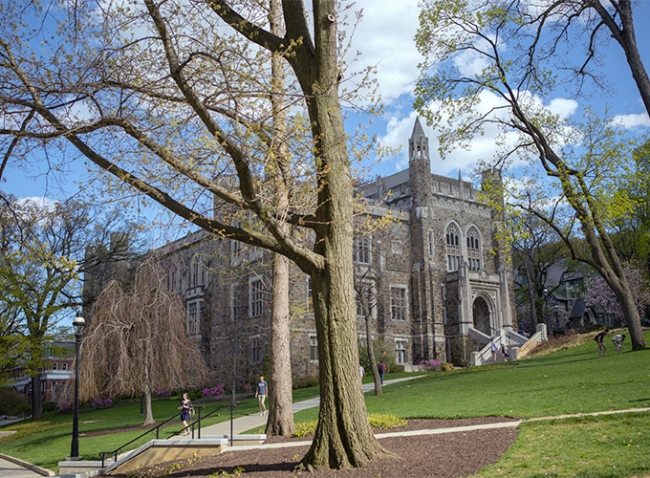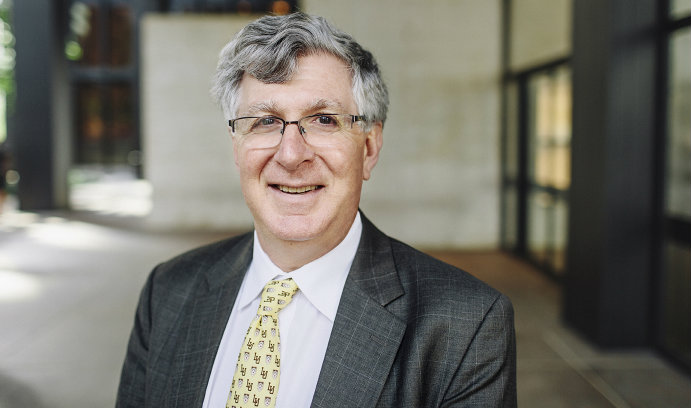You have /5 articles left.
Sign up for a free account or log in.

Lehigh University plans an ambitious expansion.
Lehigh University
Lehigh University President John D. Simon wasted relatively little time in his tenure before launching an aggressive expansion plan.
Simon started as president of the private research university in Bethlehem, Pa., in July 2015. Just 15 months later, his Board of Trustees approved a plan to expand Lehigh’s 5,100-student undergraduate enrollment by 20 percent, boost its 2,000-student graduate enrollment by up to 40 percent, hire additional faculty members and start a new college concentrating on health.
“I think people these days expect that you’re going to do something sooner rather than later,” Simon said. “The idea that you can go on a yearlong listening tour -- I don’t think anyone has that long anymore.”
Simon noted that some of the pieces needed for an expansion plan were already in place when he came to Lehigh. The university already had a strategic plan in place that included calls for expansion and an emphasis on the subject area of health. Faculty and students have generally supported the growth plans as well -- although some have noted that expansion could bring unintended consequences for the surrounding Bethlehem community and cannot be expected to fix all academic and demographic challenges Lehigh faces.
More broadly, Lehigh’s expansion ideas come at a time when many colleges and universities feel compelled to try to change in size and geographic reach in order to secure their futures. Still, Lehigh’s plans stand out as particularly ambitious. And the president’s own personal experiences told him to move sooner rather than later on big ideas.
By the numbers, Lehigh’s plan calls for raising enrollment by 1,000 undergraduates, from 5,080 today. It would increase full-time graduate enrollment by 500-800 students -- above the current level of 1,979, which includes both part- and full-time graduate students. The number of faculty members, meanwhile, would increase by 100, up from 521 full-time faculty members.
The larger number of people on campus, along with the investments in facilities required to start a new college of health, will require additional money. Estimates are that the university’s annual operating budget, which totaled roughly $475 million in 2015-16, would grow by about 25 percent. Capital investments in facilities are planned to include a renovated student union, new dormitories and a new science and research building.
Although the plans call for large investments, they’re necessary to expand and start a new college without drawing resources or students away from Lehigh’s existing programs, Simon said. Its four current colleges are Arts and Sciences, Business and Economics, Education, and Engineering and Applied Science.
“It’s an honest appraisal of the scale needed to be really successful at what we’re trying to do intellectually,” Simon said. “When you look at engineering here, or arts and sciences, or business, to steal populations from those would probably take some critical mass from programs they’re mounting and what they do well.”
The idea instead is to build the new college of health that positions the university in a new area while fitting with Lehigh’s existing strengths. It would be the major driver of growth, although Simon believes existing colleges and programs can expand as well.
For the operating budget, increases in enrollment will help to pay for faculty hiring. Capital investments will be funded by debt, philanthropy and other financing mechanisms, Simon said. He also hopes to grow Lehigh’s $1.16 billion endowment by about 20 percent to keep pace with the planned growth in undergraduate students.
Lehigh is in a strong spot to take on additional debt, according to ratings issued this fall, when the university was marketing bonds. In September, Moody’s Investors Service assigned an Aa2 rating, the agency’s third highest, to a proposed $150 million in taxable bonds and $35 million in tax-exempt revenue bonds. Moody’s cited Lehigh’s “strong balance sheet reserves and healthy operating performance” as well as its “excellent market position … strong fiscal management and ample liquidity.” The ratings agency did note, however, that Lehigh was taking on large capital investments in a competitive student market, even as it relies on student charges more than its peers.
Lehigh’s planned health college’s exact focus areas aren’t set yet. But it’s not intended to train clinicians. A faculty committee is currently considering options, according to Provost Patrick V. Farrell. They could include, for example, data analytics.
“We have a pretty aggressive program in data analytics,” Farrell said. “For a lot of the data analytics folks, this would be a really exciting and new area to work on, even though their background may not be related to health.”
The college won’t be created in a single year, Farrell said. He’s still sketching out the process to ramp it up into a full college. Lehigh described the expansion plans as a 10-year framework when it first announced them in October.
Finding new students poses one of the most critical challenges going forward. Lehigh enjoys a strong reputation in the Northeast, and administrators hope the new health college allows it to compete for more students close to home. Yet they will also look outside their traditional footprint, where Lehigh is not well-known in the same way Ivy League institutions are.
Lehigh has already made investments on the West Coast, notably partnering with the Nasdaq Entrepreneurial Center in San Francisco. It also had success in recent decades expanding its recruiting reach. Today, between 50 percent and 55 percent of its undergraduate student body typically comes from the four states of Connecticut, New Jersey, New York and Pennsylvania, Farrell said. That’s down from 75 percent 20 years ago.
The West Coast and California are attractive recruiting grounds in part for their sheer number of expected students. Projections show they will have a relatively high number of students graduating from high school in coming years. A student body drawn from a more diverse geographic area would also be a positive for Lehigh’s on-campus experience, Farrell said.
The provost does not expect to drastically increase Lehigh’s discount rate in order to attract more students. The university’s quoted tuition for the 2016-17 academic year stands at $47,920, not counting housing and other fees. Its discount rate is about 34 percent.
“We probably will increase merit-based aid slightly,” Farrell said. “But what I think we’d like to do -- and we’ve had good success so far and will continue -- is to convince students they come to Lehigh not because we’re giving them the sweetest deal or the biggest merit-based aid check, but that you want to come here because this is a place you can flourish.”
“If they knew about the character of Lehigh and the kinds of experiences students have, we’re convinced they might say, ‘This is the kind of environment we want,’” Farrell continued.
Same Strategic Plan
Farrell has been at Lehigh since 2009. That’s the same year former President Alice P. Gast released a 10-year strategic plan that was the culmination of two years of work. Yet neither Farrell nor Simon believed it was necessary to redraw the strategic plan after Simon became president in 2015.
Both believed the plan was still pertinent in many ways. Action to meet some of its goals was delayed in large part due to the 2008 financial crisis, according to Simon.
Many of the goals would remain the same if a new plan were formulated today, Farrell said. For example, the plan advocates expanding Lehigh’s faculty and a focus on the area of health. So rather than spend a year or two drawing up a new strategic plan under a new president, Lehigh’s administration decided to find elements within the existing plan that they could execute right away.
“Let’s see how we can execute on those, which is really the Achilles’ heel of any strategic plan, in my experience,” Farrell said. “I think a lot of people are excited to hear, ‘Let’s make it happen. Let’s go there.’”
University leaders don’t always bring that attitude to the planning process. But experts said it can be a best practice when possible -- particularly when institutions have initially been unable to execute good plans for one reason or another.
“I view strategic plans as a living document,” said Rick Beyer, the managing principal of AGB Institutional Strategies, in an email. “Strategic plans should be updated every few years but not necessarily abandoned simply because of a change in presidents.”
Lessons From Virginia
 Simon (at right) said he was able to hit the ground running at Lehigh in part because he had a long run-up to the presidency. He was appointed in October 2014 but didn’t start at Lehigh until the following July. During that time he was able to visit regularly from the University of Virginia, where he was provost and executive vice president.
Simon (at right) said he was able to hit the ground running at Lehigh in part because he had a long run-up to the presidency. He was appointed in October 2014 but didn’t start at Lehigh until the following July. During that time he was able to visit regularly from the University of Virginia, where he was provost and executive vice president.
But Simon’s experience at the University of Virginia also informed his approach to the presidency. He was provost at Virginia when the university’s Board of Visitors unexpectedly ousted President Teresa Sullivan in June 2012 -- two years into her tenure -- only to turn around and reinstate her two weeks later. Simon was noted as being critical of the board’s process to remove Sullivan during that time.
The Lehigh president didn’t delve deeply into his time at the University of Virginia during recent interviews. But his experience taught him to move quickly, he said.
“If you want to change anything, you have to get it started pretty soon, because you don’t have a large window,” Simon said. “I think to drive change, sustain change and do something, it takes five or 10 years. And that’s all you’ve got.”
Caution on Expansion
Yet it’s important to be careful about the expansion, said Slava V. Rotkin, a professor of physics and materials science and engineering who represents Lehigh’s College of Arts and Sciences on its Faculty Financial Planning and Operations Committee. While many faculty members support growth and research, they also know Lehigh remains a small institution that can be affected by expansion in many ways, he said.
Proving that Lehigh’s new college is high in quality will be a challenge, Rotkin said. So will finding the connections between existing departments in order to enable the new college to grow.
“I think we should see how all of that will be developing,” Rotkin said. “It’s exciting, new.”
The editorial board of Lehigh’s student newspaper, The Brown and White, also said the plans can have a positive effect if executed properly. But it cautioned that they should add to diversity among the university’s predominantly white student body, should not be confused with making academic improvements to existing operations and should not damage the community around the college.
“When we come back for our reunion, we want to see a university we can be proud of, not one that is diminished by ambitious goals and destroying a community,” it wrote.








